译林版六年级英语下册全册完整教学课件
译林版英语三起六年级下册课件Story time(1)
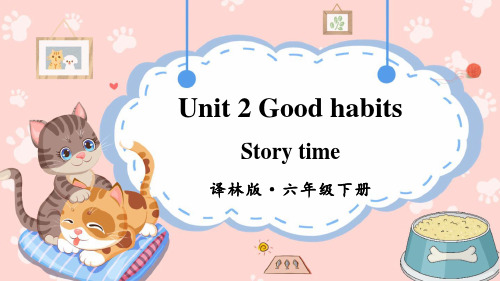
messy 凌乱的
干净的,整齐的
How do we make a room tidy?
put our things in order put … in order 把……整理得井井有条
Look and guess what Wang Bing does in a day.
get up
go to bed brush teeth
never go to bed late
keep his room clean and tidy
brush teeth help his parents go to bed late
put things in order
finish homework late at night
Let’s discuss
13. 保持房间的干净整齐
keep the room clean and tidy 14. _对__…__…__很__了__解__________k__n__o__w_____…_____w____e__ll_________
Homework
1. Review the new words in this lesson. 2. Listen and read the passage again. 3. Write down your good habits and bad habits
Match and say
What habits do Wang Bing and Liu Tao have?
e
c
fa
d
Wang Bing has some good habits. He gets up early.
Let’s read
从不
译林版英语三起六年级下册课件Project 2详案 课件
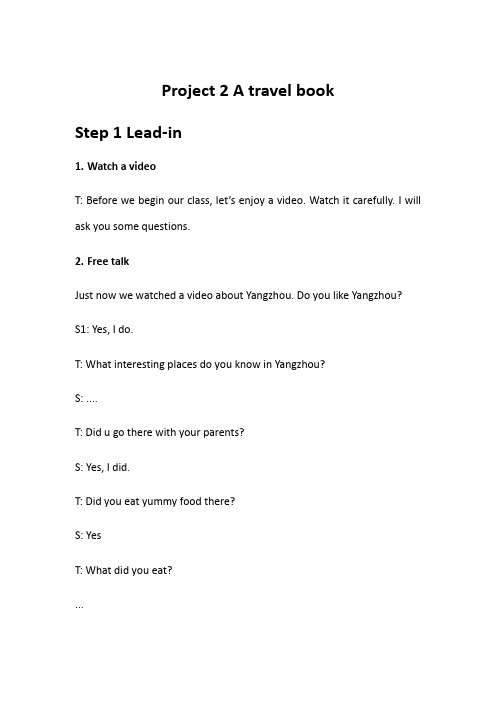
Project 2 A travel bookStep 1 Lead-in1.Watch a videoT: Before we begin our class, let’s enjoy a video. Watch it carefully. I will ask you some questions.2.Free talkJust now we watched a video about Yangzhou. Do you like Yangzhou?S1: Yes, I do.T: What interesting places do you know in Yangzhou?S: ....T: Did u go there with your parents?S: Yes, I did.T: Did you eat yummy food there?S: YesT: What did you eat?...T: Good job! Boys and girls, you watched the video very carefully. But I still have one last question. At the beginning of the video we saw a lady with a book. What book is it?S: A travel book.Step 2 Presentation1.What’s a travel book about?T: Yes, a travel book!贴标题,让孩子跟读。
T: Look! Here are some travel books. People can read the travel books before they visit some places. What information can we get from the travel books?提示孩子用we can find.....in the travel books.We can find the information of weather...... Interesting places etc.T: So travel books are important for the visitors. There are a lot of interesting cities in the world. Among them, my favorite one is Toronto.(学生跟读,往黑板上贴图片)and I want to make a travel book before I go there.First, I will draw a beautiful cover. What do you think about it? Is it beautiful?Then, I will find the information of weather, interesting places, food and special transportation.(跟读)2.Listen and completeT: Now I want to know the weather in Toronto. Let’s listen to the weather broadcast and pay attention to the key words.(点击录音机播放听力,播放两次。
译林版小学六年级英语下册全套PPT课件

精品PPT
8
Points:
1、large: 大的
例句: Too small or too large?
2、strong:强壮的
例句: You're very strong.
3、weak:柔弱的
例句: You're just weak.
4、sharp: 锋利的,尖锐的
例句: My knife is very sharp.
精品PPT
27
What would you like to know about
the story?
如果你读一个故事,你想知道什么?
Where?
When?
Who?
What行为
精品PPT
How情感
28
Watch and answer.
in the forest
Where?
the first day the next day
精品PPT
7
Points:
1、walk by:走过
例句:I saw Xiao Yang walking by with a smile.
2、wake… up:叫醒某人
例句:I didn't wake up until I heard the alarm clock.
3、let…go:释放;放开
例句:Let me go.
精品PPT
37
Who was strong?
精品PPT
38
Picture 3 the next day…
• Read in groups.小组朗读讨论 Ask and answer. 问与答
Accident!
精品PPT
苏州市译林版六年级英语下册第四单元全部课件(共5课时)

Read and choose!
To cross the road, we must look (looks,
look) for a zebra crossing. At the zebra crossing,
we must look (look,looking) at the traffic lights. We must wait (waiting, wait) for the
1
Let’s imitate.
Do you remember?
• How to cross the roads safely • First look for __a_z_e_br_a_c_r_o_ss_in_g__ • Then look at __th_e_t_r_af_fi_c_li_g_h_ts__ • Traffic lights mean different • __R_e_d_m_a_n___ stop • _G_r_e_e_n_m__an__ go • You must wait • On the road!
Unit 4 Road safety
Checkout time & Ticking time
We must…
We mustn’t…
onathheomroead
Rule(规则)
用所给句型说出相关地点的规则,轮流进行,重复或错误不得分。
Read and underline
Discuss the differences between
Different rules around us.
Different places,different rules.
We must follow different rules in different places.
译林版(三起)英语六年级下册Unit4 road safety story time课件
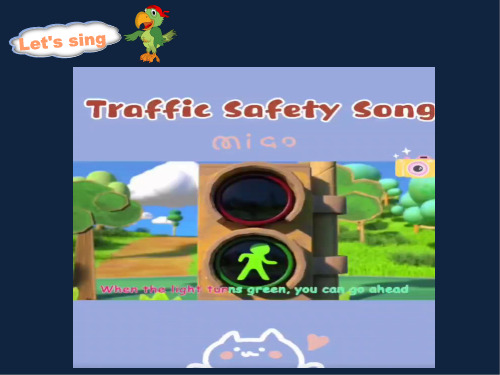
表示降调 表示停顿
Do you remember?
How to cross the road safely? First look for _a_z_e_b_r_a_c_r_o_ss_i_ng__ , Then look at _t_h_e_t_r_a_ff_i_c_l_ig_h_t_s . __R_e_d_m__an___ stop, _G_r_e_e_n_m__a_n_ go, You must wait, On the road!
pavement(人行道)
/'peɪvmənt/
/ˈkrɒsɪŋ/
crossing (十字路口)
/'zebrə /
zebra crossing(斑马线)
/'træ fɪk /
traffic lights 交通灯
zebra crossing这安些全设通施t行r可a。f以fi帮c 助lig我ht们s在马路上pavement
哪一队同学获胜了呢?
恭喜你们成为道路安全 标兵,快贴上安全勋章 吧!
Let's vow together! 让我们一起来宣誓吧!
➢ I must learn more about safety rules. ➢ I must follow the safety rules. ➢ I must help others to be safe. ➢ Start from me! Start from now!
again. ( T ) 3. It’s safer to cross the road with other people.
Because the drivers can see you eaily.
eAasy 容易的
译林版六年级英语下册全套课件
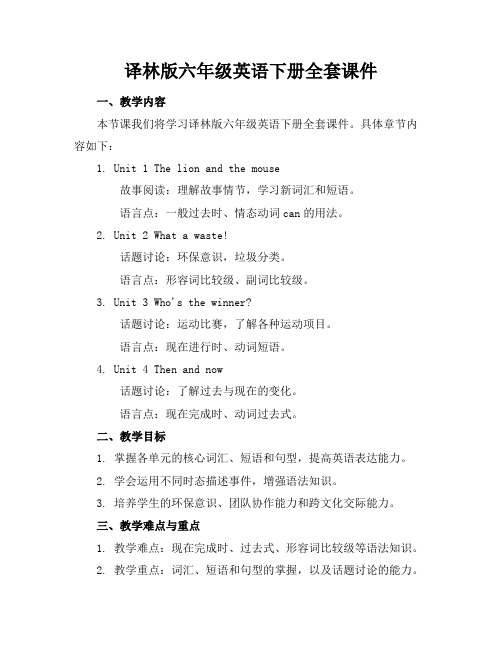
译林版六年级英语下册全套课件一、教学内容本节课我们将学习译林版六年级英语下册全套课件。
具体章节内容如下:1. Unit 1 The lion and the mouse故事阅读:理解故事情节,学习新词汇和短语。
语言点:一般过去时、情态动词can的用法。
2. Unit 2 What a waste!话题讨论:环保意识,垃圾分类。
语言点:形容词比较级、副词比较级。
3. Unit 3 Who's the winner?话题讨论:运动比赛,了解各种运动项目。
语言点:现在进行时、动词短语。
4. Unit 4 Then and now话题讨论:了解过去与现在的变化。
语言点:现在完成时、动词过去式。
二、教学目标1. 掌握各单元的核心词汇、短语和句型,提高英语表达能力。
2. 学会运用不同时态描述事件,增强语法知识。
3. 培养学生的环保意识、团队协作能力和跨文化交际能力。
三、教学难点与重点1. 教学难点:现在完成时、过去式、形容词比较级等语法知识。
2. 教学重点:词汇、短语和句型的掌握,以及话题讨论的能力。
四、教具与学具准备1. 教具:多媒体课件、实物、图片、卡片等。
2. 学具:教材、练习册、文具等。
五、教学过程1. 导入:通过图片、视频等引入话题,激发学生兴趣。
2. 新课内容展示:呈现课件,讲解词汇、短语和句型。
3. 例题讲解:结合实际情景,讲解语法知识,进行例题演示。
4. 随堂练习:设计练习题,巩固所学知识。
5. 小组活动:分组讨论,培养学生的团队协作能力。
六、板书设计1. 核心词汇、短语和句型。
2. 语法知识框架。
3. 话题讨论提纲。
七、作业设计1. 作业题目:Write a short story about "The lion and the mouse" using the past tense.Describe the changes in your life from the past to the present, using the present perfect tense.答案:略八、课后反思及拓展延伸2. 拓展延伸:邀请学生分享自己的故事、经历,提高口语表达能力。
译林版英语六年级下册Unit 7 Summer holiday plansStory time课件
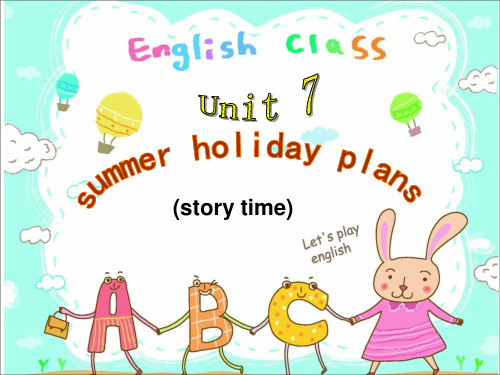
ITwhailt选l’sg择ow一toh个ned你ree喜r.f.欢u. l的. H节o日w谈lo论n你g们w的ill计y划ou。stay
there?
B: ...
A: What will you do there?
B: ...
A: Will you …?
B: Yes, I will. / No, I won’t.
、
Task1: Watch, match and say.
LTreWyarhtnoeirsneagywT:ililptsh:ey go for the holiday?
个MSuik人He1aw和i快iwll他ig速llog们浏toot计…o2览…划全去文Y的L,aiun地完Tg3aL方o成inwg连练ilwl 线g习ilol g。t一oo4…t,o …把每
That’s wonderful. I want to see the city too.
OK. I’ll show you some photos after the holiday.
Thanks !
Su Hai and her __f_a_m_i_ly__ will visit _D_is_n_e_y_l_a_nd and __O_c_e_a_n__P_a_r_k__ in Hong Kong. Liu Tao will go to ____T_a_i_p_e_i _____ with his _p_a_r_e_n_t_s___. He will take some __p_h_o_t_o_s___ and show them ___a_f_t_e_r__ the holiday.
Read and write
a month
London
牛津译林版英语六年级下册精品课件
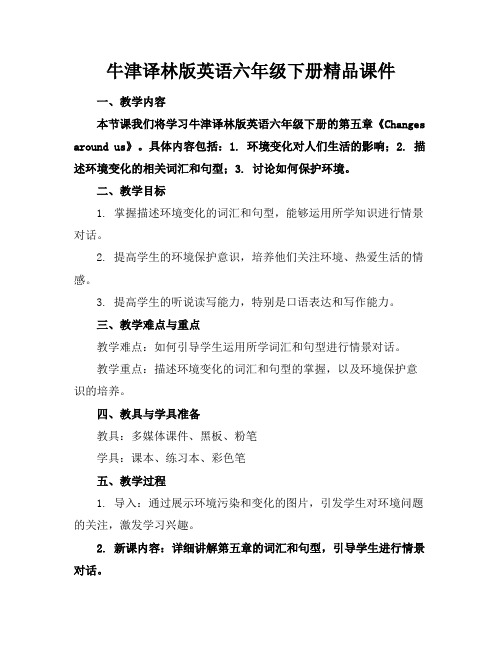
牛津译林版英语六年级下册精品课件一、教学内容本节课我们将学习牛津译林版英语六年级下册的第五章《Changes around us》。
具体内容包括:1. 环境变化对人们生活的影响;2. 描述环境变化的相关词汇和句型;3. 讨论如何保护环境。
二、教学目标1. 掌握描述环境变化的词汇和句型,能够运用所学知识进行情景对话。
2. 提高学生的环境保护意识,培养他们关注环境、热爱生活的情感。
3. 提高学生的听说读写能力,特别是口语表达和写作能力。
三、教学难点与重点教学难点:如何引导学生运用所学词汇和句型进行情景对话。
教学重点:描述环境变化的词汇和句型的掌握,以及环境保护意识的培养。
四、教具与学具准备教具:多媒体课件、黑板、粉笔学具:课本、练习本、彩色笔五、教学过程1. 导入:通过展示环境污染和变化的图片,引发学生对环境问题的关注,激发学习兴趣。
2. 新课内容:详细讲解第五章的词汇和句型,引导学生进行情景对话。
3. 例题讲解:针对本章的重点知识,进行例题讲解,帮助学生巩固所学。
4. 随堂练习:设计相关练习题,让学生即时巩固所学知识。
5. 小组讨论:分组讨论如何保护环境,培养学生的合作精神和环境保护意识。
六、板书设计板书内容包括:第五章、重点词汇、句型、例题及答案。
七、作业设计1. 作业题目:请运用本章所学词汇和句型,写一篇关于环境保护的短文。
八、课后反思及拓展延伸本节课结束后,教师应反思教学效果,针对学生的掌握情况,进行针对性的辅导。
同时,鼓励学生关注生活中的环境问题,将所学知识运用到实际中,提高他们的环境保护意识。
拓展延伸方面,可以推荐学生阅读关于环境保护的英文文章,提高他们的阅读水平。
重点和难点解析1. 教学内容的情景引入2. 教学目标的制定3. 教学难点与重点的把握4. 教学过程中的例题讲解与随堂练习设计5. 板书设计6. 作业设计一、教学内容的情景引入情景引入是激发学生学习兴趣的关键环节。
针对环境变化这一主题,教师可以选择贴近学生生活的实例,如附近河流的污染、空气质量问题等,以图片、视频等形式展示,让学生直观地感受到环境变化对生活的影响,从而引出本节课的主题。
- 1、下载文档前请自行甄别文档内容的完整性,平台不提供额外的编辑、内容补充、找答案等附加服务。
- 2、"仅部分预览"的文档,不可在线预览部分如存在完整性等问题,可反馈申请退款(可完整预览的文档不适用该条件!)。
- 3、如文档侵犯您的权益,请联系客服反馈,我们会尽快为您处理(人工客服工作时间:9:00-18:30)。
One day, a mouse walked by and woke the lion up... The next day, two men caught the lion with a large net... Just then, the mouse saw the lion. “I can help you,” he said... From then on, the lion and the mouse became friends.
译林版
六年级
(下册)
[精品]
Unit1 The lion and the mouse
(Story time)
1.能正确朗读故事并理解故事内容。 2.能听懂、会读单词large, strong, weak,
net, sharp, sadly, happily, hole。 3.能听懂、会读不规则动词过去式
有表情地分组朗读,并 注意模仿语音语调噢!
d
a
e
c
f
b
1.复述Story time中的故事。 2.预习Grammar time内容。
4. How did the mouse help the lion?
The mouse made a big hole in the net with his teeth.
The lion and the mouse became friends.
become---became
5. What did the lion and the mouse become? They became friends.
ask sadly伤心地问
3. How did the men catch the lion? They caught the lion with a large net.
net 网
make a big hole 制造一个大洞
Just then, the mouse saw the lion. “I can help you,” he said. Soon, the mouse made a big hole in the net with his teeth. The lion got out. “Thank you!” said the lion happsialyy. happily 开心地说
5. What did the lion and the mouse become?
say quietly 小声地说 laugh loudly 大声地笑
wake---woke wake...up 吵醒
One day, a mouse walked by and woke the lion up. The lion was angry and wanted to eat the mouse. “Please don’t eat me. I can help you some day,” said the mouse quietly. “You’re so small and weak! How can you help me?” laughed the lion loudly. Then, he let the mouse go.
weak-woke, bite-bit, let-let。
How was your Winter holiday? What did you do in the Winter holiday? Did you ...?
What are you going to do this term? I’m going to ...
( 2 ) The next day, two men caught the lion with a large net... ( 1 ) One day, a mouse walked by and woke the lion up... ( 3 ) Just then, the mouse saw the lion. “I can help you,” he sai ( 4 ) From then on, the lion and the mouse became friends.
The lion and the mouse
lion 狮子 large 大的 strong 强壮的
There was a lion in the forest. He was very large and strong.
small weak 虚弱的
( ) The next day, two men caught the lion with a large net... ( ) One day, a mouse walked by and woke the lion up... ( ) Just then, the mouse saw the lion. “I can help you,” he said ( ) From then on, the lion and the mouse became friends.
1. Who woke the lion up? The mouse did.
2. Did the lion eat the mouse? No, it didn’t.
sharp 尖锐的
bite-bit 咬
The next day, two men caught the lion with a large net. The lion bit the net with his sharp teeth, but that did not help. “How can I get out?” asked the lion sadly.
同学们,讲故事时如果用以上四个词开头, 可以让你讲的故事更有条理性噢!
1. Who woke the lion up? 2. Did the lion eat the mouse? 3. How did the men catch the lion? 4. How did the mouse help the lion?
